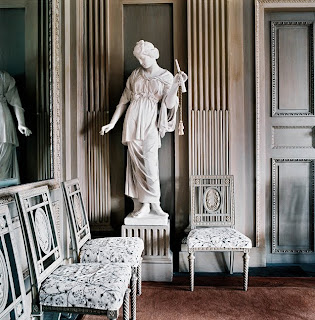
The elegant 18th-century interiors of Gunnebo Slott near Gothenburg, Sweden are an unknown treasure of neoclassicism. Photographer Christopher Flach’s never-before published images show the superb symmetry, grace and harmony of Gunnebo’s interiors.
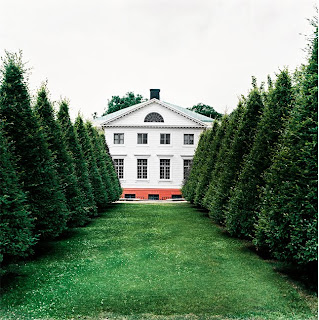
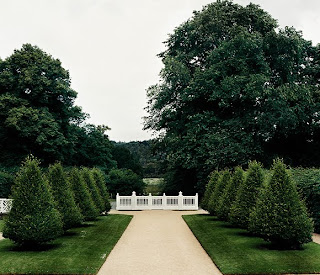

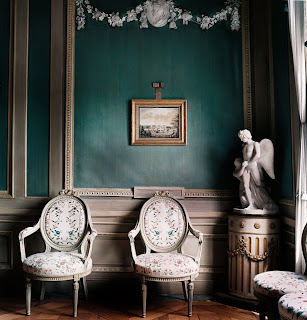


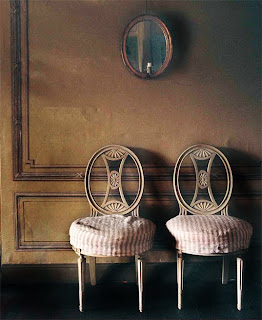


For many summers I have been traveling to Sweden to visit castles, mansions, palaces and estates and pavilions in the region around Stockholm. No season seems happier and more glorious and than summer in Sweden. It’s brief, and winter comes fast. Long sunny days are spent on the water, sun-bathing on islands in the archipelago, visiting estates, or wandering through the gardens of Stockholm and its lake-filled hinterlands.
I land in Stockholm in mid-August, and head out immediately to visit Haga Pavilion, Drottningholm Palace and its glorious Chinese Pavilion and the manor houses on Skansen.
It’s neoclassicism I come to enjoy—Swedish style.
I wander in a happy, golden daze from the Grand Hotel (where I always stay), to the Royal Palace, then back over the bridge to Lisa Elmquist’s for lunch (smoked salmon), take a wander around Ostermalm. I’ll climb the stairs of the National Museum to see the Rembrandts and Swedish Impressionists, and later meet friends at Wedholm’s Fisk for dinner or Fredsgatan12 for late supper. Every view is framed by the lakes and waterways of Stockholm. I feel my best.
It’s still sunny at almost 11pm, so after dinner I might take a ferry to Vaxholm in the archipelago for an ice cream, before heading back to the city. Back at the Grand, I make sure, before I turn in, to close my bedroom curtains tight to keep out 2am sunlight.
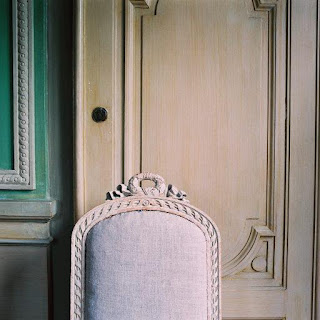
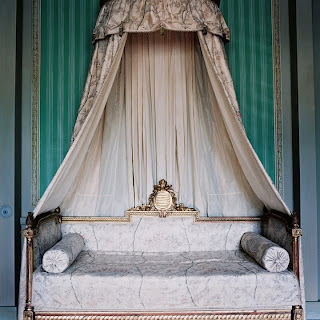


Next day, I am heading for Drottningholm on the old ferry that leaves from the dock near City Hall. I eat cloudberries and cream as we drift along the lake, and arrive just in time to attend the opera at the Gustavian opera house near the castle.
I take the last ferry back to the Grand, but it is still sunny and golden, so I walk around the deserted city, perhaps stopping at the city’s Gustavian opera house ’back pocket’ bar for a sip of Champagne.
The Swedish interpretation of neoclassicism is a lot less gilded and formal than the French approach. Here in the north, wood was plentiful, and woodcarvers and cabinetmakers did their best to emulate the French taste—and failed wonderfully. These country cousins of Versailles crafted a humbler version of Louis XVI, with less embellishment or four-four. From French drawings, they produced somewhat more pared-down chairs and settees and covered them with hand-woven cottons and printed chintz rather than silks woven in Lyon.
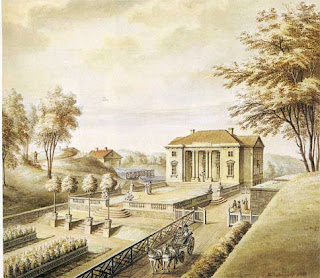


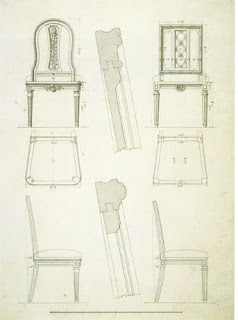
In Gothenburg stands one of Sweden’s less known mansions, on a country estate far from Stockholm and the richer south.
Gunnebo Slott was built at the end of the 18th century as a summer residence for wealthy merchant John Hall. The house was described as "the most beautiful and exquisite wooden building in the kingdom". It is one of Sweden's best examples of neoclassical architecture.
Gunnebo Slott today is a working farm with rare Swedish sheep and fowl, and it has superbly maintained formal gardens. Clipped yews and hand-trimmed hedges give away the French inspiration.
The Swedish name, Gunnebo Slott, is often translated to Gunnebo Castle, though there is nothing fortified about it. Slott in this case should more correctly be portrayed in English as a mansion or an estate, perhaps Gunnebo House, in the English manner.
The name Gunnebo first appeared on maps at the end of the 14th century and in a list of properties owned by the church. At the time the estate was called Gunnebodher or Gunnebodum.
In 1778 Hall purchased more than one hundred acres on which to build a summer villa. Carl Wilhelm Carlberg, the town architect of Gothenburg, was commissioned to plan and design the estate, including the interior decoration, most of the furniture, the landscape, and the surrounding farm buildings and dependencies.
Carlberg, like King Gustav, his court, and many intellectuals and architects of the day, had undertaken an adventurous formal study trip abroad. These Grand Tours were popular in the day in spire of the arduous nature of travel. Carlberg, like the short-lived King Gustav III, was heavily influenced by the prevailing neoclassical ideals and could not wait to incorporate the orderly and elegant architecture and furniture into his work.
Carlberg was also an admirer of Andrea Palladio, whose formal-yet-informal villas in the Italian Veneto around Vicenza and Verona are considered among the most influential architectural models internationally.
Palladio has been loosely interpreted here. It’s Gustav-meets-Palladio build in wood.



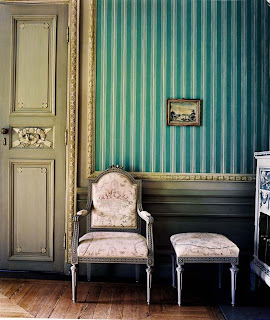
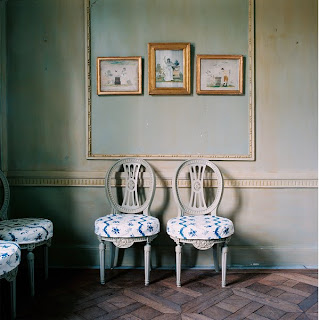
After Hall’s death, the house passed through several hands, and over decades it was neglected. It is now in the hands of the local municipality and is superbly maintained. Unlike many historic houses around the world that are owned by public bodies, this one feels alive, as if a family lived there. Fresh flowers from the gardens bloom on tables. Curtains seem to billow in the breeze.
New York photographer Christopher Flach recently spent several glorious summer days photographing at Gunnebo Estate.
Flach reports:
“Wandering through the Gunnebo Slott, I fell in love with 18th century light. For me Gunnebo Slott is about summer, and about the Swedish people.
“Gaining permission from the museum director to roam and photograph, was a gift. This is the most beautiful and exquisite wooden building in Sweden.
“As a residence for the wealthy merchant John Hall, the house was filled with Sweden's best examples of neoclassical architecture and furniture as well as statuary, in the manner of Canova.
“I am a great admirer of the Renaissance architect Andrea Palladio.
“Gunnebo Slott was recently renovated, using the original drawings and documentation. It fell into disrepair several times, and was saved by its 20th century preservationists, Baroness Hilda Sparre and her husband Baron Carl Sparre.”
Today Gunnebo Slott is a museum, open for all to enjoy.
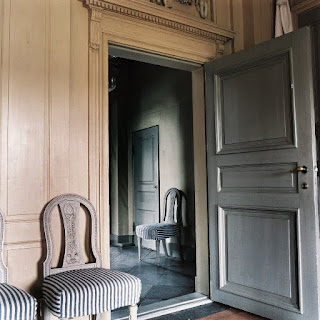
Photographs of Gunnebo Slott by Christopher Flach have never been shown or published previously. Flach’s images of Gunnebo Slott offer a privileged tour of the late 18th-century rooms, an ode to neoclassicism in Sweden. All images were photographed by Christopher Flach, who holds the copyright.
To contact Christopher Flach:
[email protected]
www.flachphotography.com

19 comments:
So gorgeous!!!!!!!!!!!!!!!!!! What fabulous photographs - you are so lucky to be able to show them. And I didn't realize you go to Sweden each summer, what a treat! I feel like I just visited myself after looking at these pictures. Beautiful!!!!
Such a lovely wander through the beauty of Sweden. Thank you. I have often been fascinated by the effect of quality of light upon art and design. I find it has a strong influence on inspiration.
The images here are ethereal. They are all wonderful, the first grouping is dreamlike, especially the first exterior,don't you agree?
I love the parquetry floors and their starved look. The Swedes interpretation is always unique-that odd ashe rose color on the walls reminds me of one used in the North Carolina Capitol. So odd and ghostly, they had it especially made, the supposed formula is not a good one- too much pink, I couldn't use it.
la
Swedish interiors are among my favorites. I adore the palettes and the symmetry. Never been to Sweden, but it is on my list. Thanks for sharing these dreamy photographs.
Catherine
Informing and transporting; thank you!
Good evening Little Augury-You are right--the light in the rooms is ethereal.Christopher Flach went to Gunnebo midsummer, and shot with no lights, only natural light. The images show Swedish design at its best. And you are right--the colors are paled down and bit murky--which is to the traditional taste in Sweden where bright colors and flashiness are tut-tutted.
Catherine-thank you for your kind comment. You are right that there is a balance and symmetry and simplicity to Swedish interiors that is very pleasing. Sweden is a luscious country and I can't wait to return...summertime only.
Jerry--welcome to THE STYLE SALONISTE. Do come and visit often. It would be lovely to hear from you.
all best, DIANE
Thanks for letting us having a tour of this neoclassical wonder !Love all these statues around the room
Diane,
I have died and gone to heaven! Thank you again for another enlightening post.
Michael
Sweden is a huge surprise for most folks...I never thought I would love it as I do..Gunnebo Slott and the Chinese Pavilion at Drottningholm could make you cry! I,too, love the Grand Hotel..we should be there having cloudberries and ice cream.
Hello, Melanie, Michael and Sally-
Loved receiving your notes this morning.
The interiors are indeed magic--and should be motivation to return to Sweden. Yes, we should be in Sweden now, sitting at the Grand Hotel eating smoked salmon or herring, followed by cloudberries and cream (which I always eat on the ferry to Drottningholm to see the opera.
The key to the beauty of these images--you have not seen them before, you see them with 'new' eyes, and they were shot with natural light! Swedish light is so luscious and it needs no help from strobe lighting. Thank you all for your enthusiasm. xx D
Hi Diane,
Thank you so much for the lovley comment you left on my blog {absolutely beautiful things} today!
Kind regards,
Anna
Thanks for the ravishing images. I cannot wait to make my own summer pilgrimage to Sweden. I love Christopher's work -- in fact, I have his large image of Palladio's La Rotunda on my bedroom wall. It is the first thing I look at in the morning, which is not a bad way to start the day!
Hi Diane, thanks for the comment on my blog today...I just realized that you are in Sweden right now, so have a glorious time. This post is gorgeous window into Neoclassicism, one of my very favorite design styles.
thanks and enjoy!
I wanted to pop in and thank you for inspiring me to start my very own blog.
Sweden must be divine just now and thanks much for these wonderful photos.
Hope you'll drop in and check my posts when you have a moment.
http://caftanchronicles.blogspot.com/
Hello, Philip-
So pleased you are following along on my peregrinations.
Loved published Martha Angus profile last week--with your fine work superbly on display.
Chic-Kit-Yes, neoclassicism is a world I love to inhabit. I will be showing more interiors this week--definitely influenced by the best of enoclassicism.
Caftan! Welcome to my salon--and I am so thrilled and delighted I have seduced you into the world of blogging. You will be such a wonderful new voice and vision, with your own focus and passion and ideals. i am so delighted.
all best, DIANE
I have several design personalities & living life in a Swedish neoclassic home would sooth the soul of one (it's those Scandinavian roots). To travel in your shoes Diane if only for one summer. This was such an informative, beautiful post; I enjoyed it tremendously. Thank you very much for adding me to your blog roll. I was thrilled to be in your company. I admire you greatly. All the best to you for a terrific week ~ Deborah
Dear Diane,
I spent two weeks sailing the Stockholm archipelago and there is no place more glorious on earth than Sweden at the height of the summer months! Thank you for sharing this Diane.
B
Thanks for sharing your experience. I love this one!
Tracey
TKID
Hi, nice pictures! Note that I, Christopher has the same surname, Flach U.S. residents, which I think Christopher live in, is my understanding that family, I have ever heard that all Flach with spelling FLACH are related, the name will probably originally from Alsace and from late 1100 or early 1200: speech, 1209 is the first year I came to. I read in Swedish Riddarhuskalender stating that Flach is an ancient German lineage, to relatives in bla United Kingdom and the United States, the Flach who first came to Canada was John Fredrich Flach, 1684, I believe firmly. We Flach in Sweden belong to now, since 1720 the Swedish House of Nobility ........ Best wishes to Christopher Flach! Sincerely: Hans.J.Flach // Gävle // Sweden.
Post a Comment